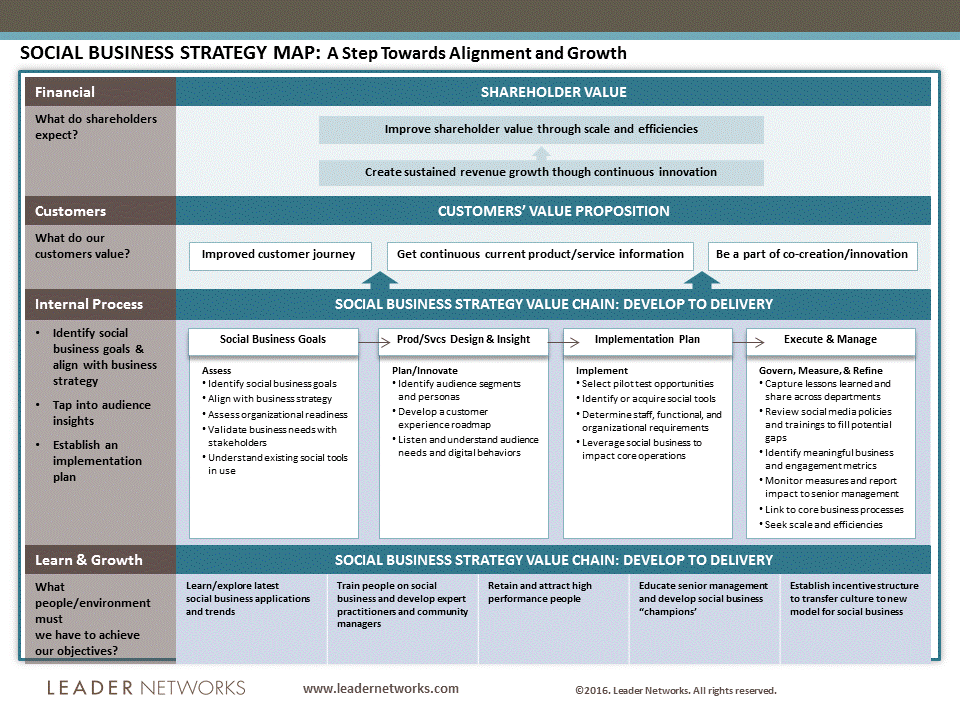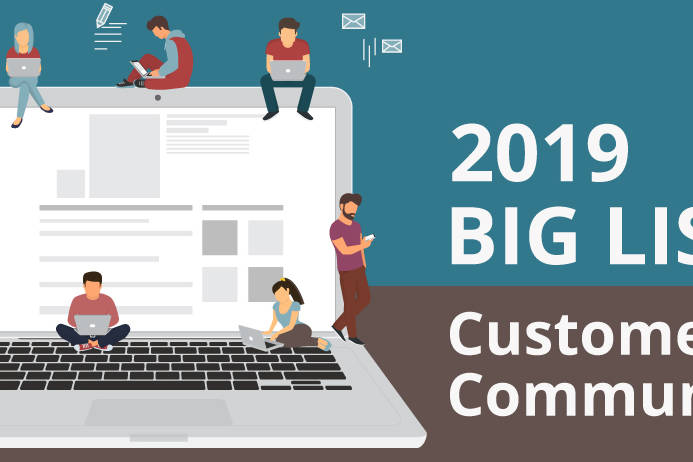
Back in 2010, I sounded like Henny Penny. Instead of telling people, “The sky is falling!” I was telling them, “Social media isn’t just about marketing – it will impact all parts of your business!”
Back then, to help my clients think strategically about social, I worked with Palladium Group (founders of the Balanced Scorecard) to develop a Social Business Strategy Map. We based the map on my experience developing strategic frameworks for more than 30 companies. Our goal was to ensure that companies were aligning their strategies with their operations. Some forward-looking CMOs got on board – but mostly, companies just weren’t ready to frame this emerging field in a larger business context.
Today, CMOs are squarely at the helm of their companies’ social business initiatives.
Fast forward to 2016. CMOs are now well acquainted with social media’s organizational impact. They’re no longer using it as a mere broadcast marketing mechanism. They’re leveraging social media across the enterprise – to serve customers, inform product and service innovations, reduce costs, and boost shareholder value.
As the market has matured, I have adapted and refined our Social Business Strategy Map to reflect the new insights I’ve gained through helping hundreds of organizations become social businesses.
Now available: The new and improved Social Business Strategy Map.
(click to enlarge)
Whether your organization is large or small, B2B or B2C, product or service focused, it is critical that you develop a social business strategy that is aligned with your operations. Here’s how this map helps you do that:
- Shareholder and customer value
When social media was in a more experimental mode, marketers tended to use it as a broadcast or marketing opportunity, and didn’t really understand or pay attention to the impact that social media has on shareholder and customer value.
Savvy marketers now realize that they must dedicate the same level of rigor and planning to their social strategy as they would to an innovation project or a new business line.
Start with a hard look at how your organization generates shareholder and customer value. For example, if social business will help your organization deliver customer value by making you “easy to do business with” and create shareholder value by “lowering operating costs” or “increasing the speed of innovation” then you’ve found a sweet spot where you should focus your social business efforts.
- Internal and operational value
Once you have locked down your shareholder value and the customer value propositions, the heavy lifting begins. Marketers must look at the internal and operational value that social media can deliver using four key steps:
- Define social business goals to support business goals
Too often, organizations jump into the deep end of the social business pool in a rush to get up to speed competitively. Be sure to look before you leap. Not every organization is built to undertake an enormous transformation effort to become a social business. Your organization may want to dip its toe into the water by using social media to support and augment certain areas.
You don’t want to open a can of worms in terms of visible exchange and interactivity if you don’t know what your risks and challenges are and how you are going to manage them. For instance, an organization that is not strong in customer care in general probably shouldn’t forge into social customer care initiatives. Doing so will shine a spotlight on where their weaknesses lie.
Ready your organization by aligning your social business goals with your business goals. Then, look at your processes and fix the problems before you move forward. Remember the golden rule: social is in service of the business and not a silo!
- Tap audience insight to drive product and service innovation
When it comes time to innovate, listening to your target audiences is the most important thing you can do. Why? Say it with me again: social media is not a broadcast mechanism. If you use your existing CRM data to understand what makes your customers tick, you have an opportunity to focus on supporting and engaging these people more intensively.
Do your research to identify where your core constituency is aggregating. Hint: It’s not at the top of a Google search on your company’s name. Your target audience is having important conversations in smaller, niche arenas. So dig deep to find the influencer communities where you can listen to and interact with your most important current and prospective customers.
Let’s say you’re a car company. There are many “motor head” communities where deep information and insight is being shared among expert practitioners. For example, while the obvious hashtag #lexus on Twitter is useful for general fans and consumers, there is a longstanding and vibrant discussion going on at #lexusRCF about the power, torque ratio, and drag coefficient of the cars’ spoilers. Now that’s where you’ll find a passionate group of consumers!
Once you’ve identified who you want to reach, and where you can reach them, then define what you hope to get from that interaction: Is it testimonials? Better understanding of their issues and problems? Better support for a product or service?
- Establish an implementation plan
When you have established who you want to serve and in what ways, then your implementation plan becomes critical.
Often, when I work with marketers and CMOs within enterprises, their social business efforts lie on top of their “day jobs” without any additional time or resources. And, there’s often an imbalance between what the anticipated outcomes are for social programs and the amount of effort and attention that needs to be put into them.
If you want ROI from your social business initiatives you need a real, robust, refined implementation plan that answers the tough questions: Who owns the program? What are they going to do? Over what period of time? In what ways? And, of course, what is it going to cost?
This implementation plan must take the form of a detailed project plan – complete with deadlines and contingencies. No fuzzy dates and squishy scopes allowed.
- Govern, measure, and refine
The ability to connect the data you gather through social channels back to the core business and shareholder value is the most important thing you can do. But that’s the Achilles heel in most measurement efforts. Truckloads of social business data is generated, but we still struggle to apply the insight.
For example, it’s not uncommon for marketing to interact with a broad base of customers – and to have fabulous insight into their wants and needs. But, because marketing is disconnected from product development, this insight doesn’t get translated into new product releases or service offerings. That’s a fail.
We’re facing a unique time in social business governance – driven by the agile nature and low price point of the social business applications that organizations are investing in. These days, marketing has a greater spend than IT, and marketing is beginning to make social business investments that are duplicative, not aligned with company standards, and not integrated with the IT backbone. That results in a widening gap between marketing and IT – and a negative impact on the business.
The bottom line? For social business initiatives to succeed, there has to be closer collaboration between marketing and IT – with a clear focus on serving the lines of business.
- Learning and growth
At the end of the day, social business is all about human processes. The ability to translate raw data into actionable results that impact the bottom line requires new skills and new rules. If your people aren’t on board with and educated to deliver against your social business initiatives, then a massive breakdown can occur.
Ask yourself, “Are we ready for this and what do we need to get ready?” Is your staff equipped to deliver on what is being asked of them as digital professionals? If not, what do they need to grow their skills? Since social is a fast moving industry, training and education cannot be a one-and-done scenario. It will require an ongoing commitment to learning. Remember that social business expertise can be found in all pockets of the organization. Look to the knowledge workers and millennials who are native to collaboration.
As we enter 2016, strategy is more important than ever.
In our quest for speed and agility, we are bypassing critical steps in creating solid business architectures. Paradoxically, by slowing down the process – and focusing on integrated strategies – we can actually make our companies more agile. We can create infrastructures that improve quality, speed times to market, lower costs, and reduce duplicative efforts.
It’s not the sexy stuff. But alignment is required. Due diligence is necessary. And social strategies that don’t support business strategies will harm competitive advantage, not accelerate it.
So here’s your mission, should you choose to accept it.
Take this Social Business Strategy Map. Circulate it to your C-suite. Adapt it, improve it, and put it to good use. As you do, please share your strategy maps with us. You can either post them here or share them with me privately at vdimauro@leadernetworks.com. Either way, I’d be happy to give you feedback – and a standing ovation for making your business stronger and more successful.
Colbert Report Image via: http://www.reactiongifs.us/i-told-you-so-stephen-colbert/
Warning: Attempt to read property "base" on array in /home3/trusten9/public_html/leadernetworks/wp-content/plugins/wp-user-profile-avatar/shortcodes/wp-user-profile-avatar-shortcodes.php on line 665
Warning: Attempt to read property "base" on array in /home3/trusten9/public_html/leadernetworks/wp-content/plugins/wp-user-profile-avatar/shortcodes/wp-user-profile-avatar-shortcodes.php on line 665
Warning: Attempt to read property "base" on array in /home3/trusten9/public_html/leadernetworks/wp-content/plugins/wp-user-profile-avatar/shortcodes/wp-user-profile-avatar-shortcodes.php on line 665
Warning: Attempt to read property "base" on array in /home3/trusten9/public_html/leadernetworks/wp-content/plugins/wp-user-profile-avatar/shortcodes/wp-user-profile-avatar-shortcodes.php on line 665
Vanessa DiMauro
Internationally recognized independent thought leader on social business strategy and operations with a specialty in online community. I help organizations drive top line growth through innovative digital strategy design and thoughtful execution. I have successfully led 60+ strategic social business initiatives for the world's most influential organizations over my 20 years as a social business executive and serve on a number of boards. My award-winning track-record is fueled by passion, experience and research.
My work has been covered by leading publications such as the New York Times, the Wall Street Journal and CIO Magazine and was recently named a Social Marketing Master by Forbes. As a former Executive in Residence at Babson College, Olin School of Management, I am an engaging and informational educator and keynote speaker.
Related Posts
February 8, 2017
The Business Impact of Online Communities: New Study and Framework
Communities generate revenue, save money and advance competitive advantage.…
December 14, 2016
7 Digital Marketing Predictions for 2017
Predictions for digital transformation in 2017
2 Comments
Add comment Cancel reply
This site uses Akismet to reduce spam. Learn how your comment data is processed.




Thanks for the information, I was running a quest to find updated contents on Social Business.
Thanks!
Thanks for visiting the blog and glad you found information you were looking for! Feel free to reach out if you have additional needs.
Best
Vanessa